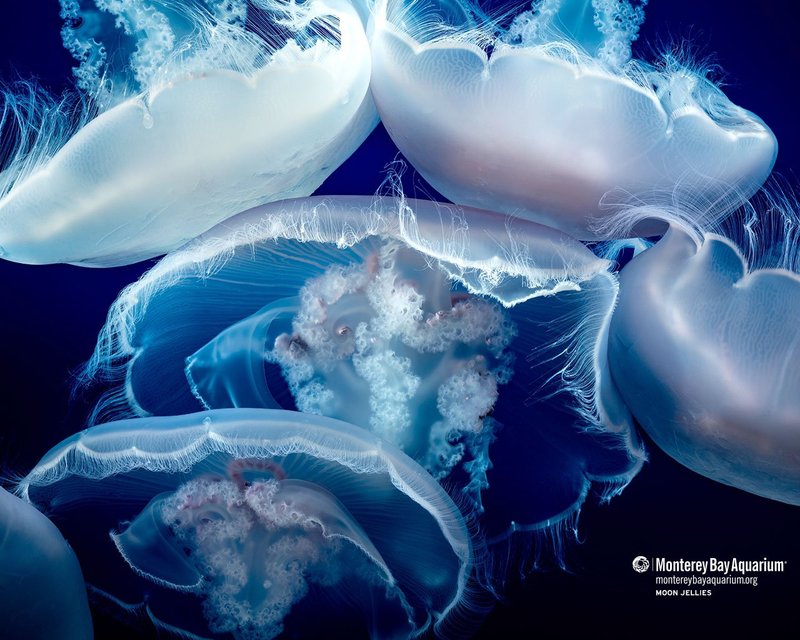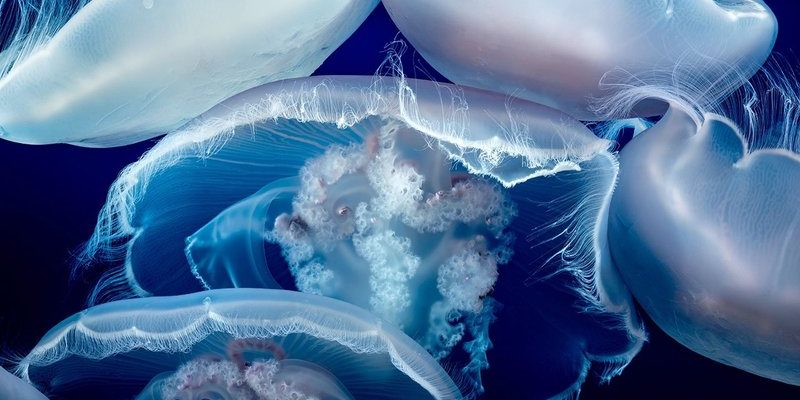
You might be wondering, how does a jellyfish contribute to the health of the ocean? Well, imagine the ocean as a bustling city where every creature has a job. The Moon Jellyfish is like a city worker, cleaning up waste, providing food, and supporting other marine life. In this article, we’ll dive deep into the various roles Moon Jellyfish play in marine ecosystems, shedding light on their significance and how they interact with their environment.
Understanding Moon Jellyfish
Moon Jellyfish are intriguing creatures. They have a dome-shaped, translucent body that can reach up to 16 inches across. Their bodies are mostly made of water—around 95%! You might find them in both coastal and open waters around the globe, from warm tropical seas to cooler temperate zones. These jellyfish are known for their gentle, drifting movements, which are powered by rhythmic contractions of their bell.
What’s so special about their anatomy? Well, besides their striking appearance, they have specialized stinging cells called nematocysts on their tentacles. These tiny cells help them catch food, which primarily consists of plankton, tiny fish, and even larvae. Their prey is abundant in the ocean and forms the base of many marine food webs. So, in a way, Moon Jellyfish serve as a bridge between microscopic life and larger marine animals.
Now, let’s get to the juicy part: their role in ecosystems. You might think jellyfish are just passive drifters, but they’re active players in the marine arena. From nutrient cycling to being a food source for various species, these jellyfish are essential for maintaining balance in marine ecosystems.
Nutrient Cycling and the Ocean’s Health
You know how a city needs a good waste management system to keep things running smoothly? In marine ecosystems, the Moon Jellyfish plays a similar role in nutrient cycling. When Moon Jellyfish consume plankton and other small organisms, they help recycle nutrients back into the water.
Here’s how it works: after digesting their food, Moon Jellyfish release nutrients like nitrogen and phosphorus into the ocean. These elements are vital for the growth of phytoplankton, the microscopic plants that form the base of the marine food web. Without this nutrient cycling, the entire ecosystem could face nutrient deficiencies, leading to a decline in marine life.
This process is crucial, especially in areas where nutrient levels might be low. By contributing to the nutrient pool, Moon Jellyfish support the growth of healthy phytoplankton, which in turn feeds small fish and larger predators. If you think about it, they’re like nature’s recycling system, helping to sustain life in the ocean.
A Food Source for Marine Life
Let’s talk about the food chain. Moon Jellyfish might look soft and defenseless, but they are a significant food source for many marine animals. Creatures like sea turtles, some species of fish, and even other jellyfish munch on Moon Jellyfish.
Imagine you’re having lunch at a café where everything on the menu is made from fresh ingredients. That’s what’s happening in the ocean! When sea turtles feast on Moon Jellyfish, they’re getting essential nutrients and energy, helping them thrive.
Interestingly, some fish species have adapted specifically to feed on jellyfish. For instance, the sunfish, known for its massive size, relies heavily on these jellyfish for sustenance. It’s like a big fish buffet! By being a part of this food chain, Moon Jellyfish help maintain the biodiversity of the ocean, supporting a variety of species that depend on them for survival.
Impact on Fishing Communities
Here’s the thing: while Moon Jellyfish play an important role in ecosystems, they can also impact human activities, especially fishing. An influx of Moon Jellyfish can sometimes lead to *jellyfish blooms*, where they multiply in large numbers. This phenomenon can have mixed outcomes.
On one hand, these blooms can be beneficial. They contribute to nutrient cycling and provide food for certain fish species. On the other hand, when jellyfish blooms become too large, they can clog fishing nets and even reduce fish populations by outcompeting them for food!
This duality means that fishing communities need to be aware of Moon Jellyfish populations. Understanding their patterns can help fishermen adapt to changes in the environment. It’s like being aware of the weather—knowing when to bring an umbrella can save you from getting soaked!
Climate Change and Moon Jellyfish
You might be curious about how climate change impacts Moon Jellyfish. As ocean temperatures rise, some research suggests that jellyfish populations could increase. Warmer waters can lead to more favorable conditions for their reproduction and growth.
But why does this matter? An increase in Moon Jellyfish can disrupt marine ecosystems even further. For example, if their populations explode, they might outcompete other marine animals for food, affecting fish stocks and other marine life.
Monitoring these changes is essential for understanding how Moon Jellyfish populations influence the broader marine environment. Scientists are working to track jellyfish blooms and their impacts, helping us make educated decisions about ocean conservation.
Conservation Efforts and the Future
Conserving marine environments is crucial not just for Moon Jellyfish, but for the entire ocean ecosystem. Various organizations worldwide are working to protect marine habitats, emphasizing the interconnectedness of life beneath the waves.
One effective approach is creating marine protected areas (MPAs). These zones restrict certain activities, allowing marine life to flourish. By protecting habitats where Moon Jellyfish thrive, we can help ensure that they continue to play their vital roles in the ecosystem.
You might also wonder how individual actions can make a difference. Simple choices, like reducing plastic waste and supporting sustainable fisheries, can contribute to a healthier ocean. Remember, every little bit counts!
The Moon Jellyfish, with its graceful movements and stunning appearance, is more than just a pretty face in the ocean. It serves as a crucial player in marine ecosystems, contributing to nutrient cycling and providing sustenance for a variety of marine life. While their presence can sometimes pose challenges for fishing communities, understanding their role helps us navigate these complexities.
As stewards of the ocean, it’s essential to appreciate the interconnected relationships of life beneath the waves. By supporting conservation efforts and being mindful of our impact on marine ecosystems, we can help ensure that Moon Jellyfish and the countless species they support continue to thrive. After all, a healthy ocean is a vibrant ocean, full of life and wonder!

